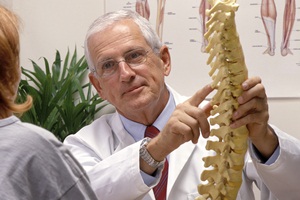 Degenerative disc disease (DDD) is a very common medical condition that affects a large and growing portion of the population. In fact, the low back pain that often accompanies DDD is the leading cause of disability in people under age 45. DDD has long been recognized as a difficult condition to treat, and many patients undergo invasive, expensive and risky surgical procedures every year in an effort to find relief.
Degenerative disc disease (DDD) is a very common medical condition that affects a large and growing portion of the population. In fact, the low back pain that often accompanies DDD is the leading cause of disability in people under age 45. DDD has long been recognized as a difficult condition to treat, and many patients undergo invasive, expensive and risky surgical procedures every year in an effort to find relief.
Part of the reason DDD can be difficult to treat is that disc degeneration itself is not really a distinct diagnosis at all. Rather, DDD refers more generally to a breakdown of the spongy cartilage discs that separate and cushion your vertebrae. This breakdown is most often caused by normal changes that occur as part of the aging process. While a majority of people will experience these changes pain-free, an estimated 85 percent of the population will show evidence of some disk degeneration by the time they reach age 50. This means that there are two important things to keep in mind when it comes to DDD:
- Most people will eventually have disc degeneration even if they do not have symptoms.
- The fact that some degeneration is apparent in diagnostic imaging does not necessarily mean that DDD is actually responsible for your symptoms (pain, reduced mobility, etc.).
WHAT CAN BE DONE—CONSERVATIVE TREATMENT OPTIONS
At the more conservative end of the spectrum, traditional treatment of DDD has usually involved finding ways to manage the pain. The most common of these is taking non-steroidal painkillers such as aspirin, ibuprofen or acetaminophen. However, it’s important to realize that this does not ultimately address the cause of the problem. The good news is that there are other conservative options available.
Many patients have found that manual therapies, such as chiropractic care and therapeutic low back massages can improve mobility and reduce pain without the need for medication. These approaches center on restoring blood flow, easing inflammation, reducing muscle tension and increasing range of motion. They can also stimulate the release of pain-relieving natural endorphins.
Non-surgical spinal decompression therapy has also proven to be effective for many patients. This treatment involves gently separating the vertebrae to reduce pressure on the spinal discs and encourage nutrients and water to flow back into them.
SURGICAL OPTIONS
Surgical options range from minimally-invasive procedures like microdiscectomies to more invasive ones such as laminectomies and spinal fusions (also called spondylodesis). Under certain circumstances, surgery may help relieve the pain caused by DDD and related pressure on nerves. While these types of techniques have become increasingly common, they all involve the risks that accompany any type of surgery. They also involve risks that are more specific to surgery on or around the spine.
Always be sure to consult your family physician and be sure to get a second (and third) opinion before undergoing any type of surgery. They can help you balance the likelihood of success against the risks and expense. Most healthcare professionals recommend that patients exhaust more conservative treatment options before choosing surgery.
EXPERIMENTAL TECHNIQUES – A LOOK INTO THE MORE DISTANT FUTURE?
Medical researchers and clinicians around the world are experimenting with other approaches to treating degenerative disc disease. Two of the more promising candidates include stem cell therapy and disc replacement. While both of these techniques are in the very early stages of development, they may eventually prove useful for the small percentage of people for whom more conservative therapies have not worked on a long-term basis.
Stem Cell Therapy
Some scientists are investigating the possibility of using stem cells to either restore the integrity of the disk or to prevent the disk’s further degeneration. Researcher Helena Barreto-Henriksson of the Institute of Clinical Sciences, and her colleagues at the Sahlgrenska University Hospital in Sweden found that when stem cells were injected into a damaged disc in animal models, they showed some healing capacity. According to Barreto-Henriksson, “Images taken by MRI showed that the transplanted stem cells survived, that they developed into cells that had a function similar to that of disc cells, and that there was a certain degree of healing in the disc.”
A similar recent study explored the use of notochord cells, which are the precursors of intervertebral discs that are present in all vertebrates, and which have been found to survive into adulthood in some animals. The study done on adult dogs found that these cells secreted a connective tissue growth factor (CTGF), which keeps cartilage healthy and flexible. If these cells can be found in the human vertebrae, therapies may be developed that would provide a simpler solution to treating DDD than surgery.

